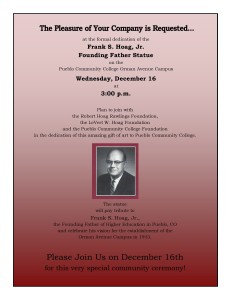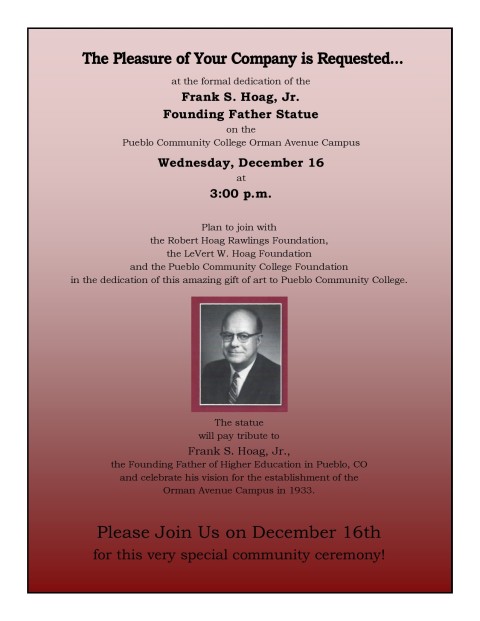Founding Father Statue at Pueblo Community College Orman Campus Dedicated
 Pueblo Community College will officially accept a life-sized bronze statue of Frank S. Hoag, Jr. on Wednesday, December 16 at 3:00 p.m. in a dedication ceremony on the PCC Campus in Pueblo (900 W. Orman Avenue).
Pueblo Community College will officially accept a life-sized bronze statue of Frank S. Hoag, Jr. on Wednesday, December 16 at 3:00 p.m. in a dedication ceremony on the PCC Campus in Pueblo (900 W. Orman Avenue).
The statue, entitled Founding Father, is a gift to Pueblo Community College from the Robert Hoag Rawlings Foundation and the LeVert W. Hoag Foundation. The statue pays tribute to Frank S. Hoag, Jr., the Founding Father of the Orman Avenue Campus of Pueblo Community College.
“We are thrilled to join with the other two Foundations in offering this new piece of art to the PCC community and the Pueblo community,” explains PCC Foundation Director Martha Simmons. “This statue will not only be an artistic addition to the PCC Campus, but the statue will offer an educational element for PCC administration, faculty and staff; by offering tangible evidence as to the rich history surrounding the establishment and continual operation of the Orman Avenue Campus, a place of higher education for the past 80 years.”
Frank S. Hoag, Jr. is considered not only the Founding Father of the Orman Avenue Campus, but as the Father of Higher Education in Pueblo. CO.
From an article which ran in the Pueblo Chieftain on June 29, 1933 which is being displayed at the base of the new bronze statue
At the age of 25, Hoag had graduated from Princeton (1931). When he returned to Pueblo, he was determined to establish a junior college in Pueblo, saying: “We had no higher education in Southern Colorado except Colorado College and the kids couldn’t afford to go away to college.”
Many people thought at the time it would be impossible. After all, it was the middle of the Depression, but Hoag was determined and Southern Colorado Junior College opened in the fall of 1933. Two years later, 17 students were in the first graduating class.
Hoag worked with a group of community leaders to help bring his dream of higher education to a reality in 1933. Those individuals who assisted in securing the formation of Southern Colorado Junior College were Dr. C.N. Caldwell, Mr. A.J. Dooner, Mr. R. D. Landis, Mrs. Roy (Hattie) Mead, Mrs. Walter O. (Margaret) Peterson and Mr. J. Arthur Phelps.
The life-sized bronze statue was created by Sutton Betti, a Loveland sculptor. Betti will be at the formal dedication on December 16 and considers this piece a “labor of love” for the PCC community.
The Pueblo Community College Foundation will be hosting the formal dedication of Founding Father on Wednesday, December 16 at 3:00 p.m. The PCC Foundation is inviting the Pueblo community to join with the PCC administration, faculty, staff and students at this wonderful event commemorating Hoag and the creation of the Orman Avenue Campus. Following the unveiling and brief dedication, guests are invited back to the Pueblo Community College Student Center for a short reception.
For more information on the December 16 Founding Father statue dedication, contact the Pueblo Community College Foundation at 719.549.3303.
Frank S. Hoag, Jr. Obituary From Princeton Alumni Weekly
Frank, retired editor and publisher of the Pueblo Chieftain, died July 24, 1989, at Mary-Corwin Hospital, Pueblo, Colo. His career with the Chieftain and its sister publication, the Star Journal, spanned nearly 60 years. Following his graduation, he was on local and legislative beats for three years prior to his assignment to Washington, D.C., as a correspondent.
There he met and married his wife of 54 years, LaVert. He succeeded his father as editor and publisher until his retirement in 1980.
Throughout his long newspaper career, Frank maintained a strong involvement in community and state affairs. He was particularly committed to higher education. He was one of the founders of Pueblo Junior College in 1933, and played a major role in nurturing the two-year school into the four-year college now known as the Univ. of Southern Colorado.
Its campus music hall was dedicated in his name in recognition of his contributions. In 1965, he was awarded the first doctor of letters degree conferred by Southern Colorado State College.
Frank’s competence was recognized well beyond the publishing field and brought him such honors as appointment by the governor to the Commission on Higher Education, Colorado Citizen of the Year, member and former chairman of the State Chamber of Commerce, elevation to the Greater Pueblo Sports Hall of Fame, and service with the Colorado Water Conservancy District.
Surviving Frank are his widow Verta, nephew Robert H. Rawlings, and a sister, Mrs. Dorothy Rawlings. To them we express our sympathy for the loss of a life so committed to others and to causes for which he will long be remembered.
Princeton Class of 1931
ABOUT THE SCULPTOR Sutton Betti
Sutton Betti’s sculptures are inspired from a stew of art forms; illustration from the early to mid-20th century, classical music, the Beatles, contemporary figurative painting and sculpture and Michelangelo’s Sistine Chapel ceiling. He is known and respected for his ability to render the human form with a spark of life. Betti’s sculptures are clearly marked by an understanding of the human body and human experiences, but his handling of negative space and composition adds to the uniqueness of this young artists repertoire of works.
Born into a family of artists and musicians, Betti first discovered his creative talents using a pencil and paper. Drawing the things of childhood imaginations brought him new found joy and friendships. As an adult he began his classical training at San Francisco’s Academy of Art College (now the Academy of Art University), cultivating his gifts in drawing, painting, sculpture and appreciation of human anatomy.
Not until Betti was hired as an assistant sculptor for Mario Chiodo did the artist realize his true calling in life. Working side by side with Chiodo’s assistants on large scale sculptures gave the 24 year old aspiring artist the passion and drive to transform his talents from amateur to expert.
During a summer trip to Italy to study Michelangelo in 1998, Betti was inspired to follow in the path of traditional art. For a period of 5 years immediately afterwards the artist lived modestly in a small garage with no running water and focused his energies on technique and produced over 100 sculptures. Most of them have since been destroyed or consumed to give life to a future piece.
In the summer of 2004, Sutton was sponsored by Danielle Anjou to study stone carving in Pietrasanta, Italy. The artist’s second trip to Italy captivated his attention with more study and hard work, carving statuary marble and learning stone carving techniques used for centuries by master Italian craftsmen.
After moving to Loveland, the sculptor immediately found work assisting other artists. He soon became employed for the sculptor Dee Clements, assisting in enlargements, mold making, wax pouring and chasing, welding, metal chasing and patinas. Working with Dee Clements has given Betti the opportunity to refine his talents.
The experience of the past two decades has brought our artist to where he is today. Betti lives and works in Loveland, Colorado where he offers private lessons and mentoring to the young. Betti also divides his time as a freelance sculptor and accepts commissions, large and small.
History of Pueblo’s Orman Avenue Campus
Pueblo Community College was the vision of its Founding Father Frank S. Hoag, Jr.
A Centennial High School graduate in 1926. Even at that young age, Hoag was concerned as he left to pursue his dreams of higher education at Colorado College that many of his classmates could not join with him in seeking higher education; due to the fact that there were no affordable institutions available in southern Colorado.
Hoag made a pledge to his fellow classmates that upon graduation from College that he would return to Pueblo and commit his efforts toward establishing some form of higher education within the boundaries of his home town.
From an article in the Pueblo Chieftain
At the age of 25, Hoag had graduated from Princeton (1931). When he returned to Pueblo, he was determined to establish a junior college in Pueblo, saying: “We had no higher education in Southern Colorado except Colorado College and the kids couldn’t afford to go away to college.”
Many people thought at the time it would be impossible. After all, it was the middle of the Depression, but Hoag was determined and Southern Colorado Junior College opened in the fall of 1933. Two years later, 17 students were in the first graduating class.
Hoag spent much time talking to community leaders about his vision for higher education in Pueblo. Eventually he gathered a group of local civic and business leaders and together this group set off to develop a plan that would formally establish an institution of higher education within the borders of Pueblo, CO; an institution that would offer its citizens better opportunities through education and vocational training.
Hoag was elected as president of the board of directors which was comprised of Pueblo community members:
Dr. C.N. Caldwell
Mr. A.J. Dooner
Mr. R. D. Landis
Mrs. Roy (Hattie) Mead
Mrs. Walter O. (Margaret) Peterson
Mr. J. Arthur Phelps
In June of 1933, Southern Colorado Junior College was formally established. The institution was forged with a mission, but had no funding, no equipment and no place to call home.
The first college leader was E. T. Kelly, who held a dual positions as Director (President) of the College and Dean. Lois Gaynor served as Registrar and Librarian. Lulu Cuthbertson served as Dean of Women and Foreign Languages instructor. Faculty appointments went to Jacqueline Given, Mathematics and Engineering; Russel Morris, Science; Mary Anderson, History, Winifred Gahagan, Speech Arts; C.K. Fletcher, Education and Psychology; Frank K. Smith, Biology; and W. F. Bricker, Mechanical Drawing.
Everyone knew that this would not be an easy task; to acquire all that was needed to “make a college” but within no time at all, the Pueblo community rose to the challenge and joined with the Board of Directors and did what they could to help with the donations of equipment, furniture and most importantly funding.
The first classes of Southern Colorado Junior College were convened in the fall of 1933. The classes were held in an unused part of the County Court House. 63 students enrolled. They paid $12 for each class, which at that time was the only source of funds the founding school needed including instructor’s salaries.
In 1935, 17 of those first 63 students succeeded in graduating from SCJC
With those first graduates, a formal site for the institution and more and more students enrolling yearly, Hoag’s initial vision was deemed as a reality and for the past 82 years, the Orman Avenue Campus has served as the site for several instituions of higher education including Southern Colorado Junior College, Pueblo Junior College, Pueblo College, Southern Colorado State College, the University of Southern Colorado, Pueblo Vocational Community College and Pueblo Community College.
In 1936, the first building on the current Orman Avenue Campus was built on land donated by the Colorado Fuel and Iron Corporation. One year later, local citizens made a commitment to support the institution with county taxes and organized the Pueblo County Junior College District, and the institution was renamed Pueblo Junior College.
Pueblo County voters approved $210,000 for building facilities in 1938 and, over the next two years, work was completed on an Arts Building and a gymnasium. In 1946, the institution gained approval for vocational rehabilitation training and a new vocational-technical building opened four years later.
In 1956, the institution’s name was changed to Pueblo College.
The Pueblo Junior College District was dissolved in 1961 when Colorado’s General Assembly enacted legislation to change the status of Pueblo Junior College to a four-year, degree-granting institution governed by the Board of Trustees for State Colleges.
The college was named Southern Colorado State College (SCSC). It grew rapidly and offered educational programs both at the Orman Avenue campus and at a newly developing campus north of Pueblo’s Belmont residential district.
Realizing the need for additional secondary, post-secondary, and adult vocational training in southern Colorado was recognized not only by the college administration but also by the community and many state agencies. Most of the Orman campus buildings had a vocational orientation, and the decision to revitalize the campus as a vocational-technical training center was based on both past programs and functional accommodations.
In 1974, Southern Colorado State College gave the name “College for Community Services and Career Education” to the vocational activities located on the Orman Campus. These vocational programs provided training to secondary, post-secondary, adult, and special students.
In 1975, the Colorado General Assembly passed legislation that would allow Southern Colorado State College to operate the College for Community Services and Career Education as a technical community college. This change was made to enable the programs to be eligible for state and federal vocational funds within the state’s Community College and Vocational Education System.
In 1978, the Colorado General Assembly passed a bill that changed the status of the College for Community Services and Career Education from a component of the University of Southern Colorado to a separate and free-standing educational entity. On July 1, 1979, Pueblo Vocational Community College became a State System Community College; and on July 1, 1982, the name was officially changed to Pueblo Community College (PCC).
By 1987, PCC had become a comprehensive community college, offering a broad range of general, personal, vocational, and technical education programs as well as providing two-year transfer programs to qualify students for admission to the junior year at other colleges and universities. Today, we place equal emphasis on both vocational and transfer degree programs.
PCC’s history of offering courses in Cañon City blossomed into a more permanent presence in 1986, when we leased facilities on the grounds of the Holy Cross Abbey. A community fund drive that raised more than one million dollars allowed us to secure $8.2 million in state funding for a stand-alone campus. Ground was broken on March 11, 2000 for a new 33,000 square foot multi-functional building. Classes were first held in the new Fremont Campus facility in fall of 2001.
Through a 1988 agreement with San Juan Basin Vocational Technical School, PCC established a presence in Cortez. Because of demand, the College also began to offer degree programs in Durango, thus forming the Southwest Campus.
Today, PCC is one of the most dynamic and progressive community colleges in Colorado. We continually strive to provide modern facilities, state-of-the-art equipment, and comprehensive technical and transfer programs that prepare students to enter the job market or transfer to a four-year school. The PCC faculty and staff are committed to student success, offering quality classroom instruction and academic support.
2015 Pueblo Community College was recognized as 4th in the nation among all two- and four-year colleges and universities in terms of long-term career success and earning power by the prestigious Brookings Metropolitan Institute.
The Brookings report, titled “Beyond College Rankings: A Value-Added Approach to Assessing Two and Four-year Schools,” was an independent study that used government and private data sources. Researchers crunched the numbers on thousands of schools that provide associate and bachelor degrees, comparing graduates’ mid-career salaries, rates of student-loan repayment, and schools’ financial aid and career-services offerings.
The report is the first to develop a measure of “value added” for two- and four-year colleges. It captures the contributions that the colleges themselves make to their graduates’ eventual economic success.
In recent years, PCC has strategically put an added focus on providing support services, with an emphasis on student success, both to retain students and to graduate them. Further, creating a student-focused culture with respect for all students has developed an atmosphere that is conducive to learning and making students want to finish their education.
Orman Avenue Historical Tidbits
1933
- The Secretary of State issues a Certificate of Incorporation to the Southern Colorado Junior College on July 13.
- SCJC will provide two years of college instruction in the arts, literature, and science, adult education and vocational opportunities as well as coursework to complete a high school program.
- Members of the first faculty of SCJC consisted of a dean, a registrar, two full-time instructors and eight part-time instructors from the public school system of Pueblo.
- Mr. E. T. Kelly was selected as Dean of SCJC (1933 – 1936)
- All expenses, including compensation of instructors, were met from the fees paid by students at the rate of $4.00 per credit hour, approximately $180 a year for a full-time program.
- 31 full-time and 32 part-time students registered.
1935
- The new campus site was given to the college by the Colorado Fuel & Iron Corp.
- Walter DeMordaunt, a Pueblo architect, was engaged to draw up plans for the new college building which would be located on the new Orman Avenue campus location.
- Construction of the building was to be done under the Works Program Administration.
- 17 students composed the first graduating class in 1935.
1936
- L. R. Wren was appointed President of SCJC and would serve in that position until 1939.
- Construction of the campus began at the Orman Avenue site and money from the City Federation of Women’s Club and the Works Program Administration was secured to pay for the new building and classroom supplies.
1937
- The Pueblo County Junior College District is formed through the Junior College Act of the General Assembly, making the college part of the public school system supported by county-wide taxes.
- The name was changed to Pueblo Junior College on June 20, 1937.
- The mission of the institution was to offer two years of general study at the college level as well as a range of practical courses for those not seeking a higher education degree.
- After four years on the top floor of the county court house the college students of Pueblo County found a new life in a new home on Orman Avenue.
- The college newspaper (The Warwhoop) published its first issue, a one-page mimeographed publication.
- The 1937/38 school year culminated with the publication of the first college year book, named then and until 1972 as the “Tsanti” meaning “Behold”.
1938
- Physical education instructor Dale Rea starts the intercollegiate athletics program which in its first year consisted of football and basketball, both coached by Rea. By 1939, the Empire Conference is formed and managed by Rea, joining Colorado and Nebraska junior colleges together in competition (the precursor to the modern day NJCAA Region IX).
- A special election was held on September 30, at which time the voters of Pueblo County voted in favor of an expenditure of $210,000 for increased building facilities on the new campus.
- Maroon and grey were chosen as the colors of the school and the Indian head as the emblem of the Junior College.
1939
- Charles E. Haines, PhD was appointed as President of Pueblo Junior College (1939 – 1942).
1940
- February 8, 1940 marked the completion of construction of the Arts building and the Gymnasium. The new gymnasium would seat 1104 persons and become the largest basketball court in southern Colorado.
- Golf, tennis and track and field were added to the intercollegiate athletic program.
1942
- Due to World War II, President Haines is called to serve in the US Navy. He resigns his position and is replaced by Dr. William Black (1942 – 1945).
1943
- A lease in the amount of $100 per month and with the option to buy later for not more than $86,000 was negotiated to take over the building formerly owned by the Rood Candy Company. The building consisted of four floors and became the birthplace of vocational-technical education. The incentive was education for war production.
- PJC would cooperate with the high schools of the county by permitting high school seniors who were recommended by the principals and superintendents to attend junior college.
- PCC would allow the nurses of the Parkview Hospital to take a course in Microbiology at Pueblo Junior College.
1945
- Marvin C. Knudson was selected as President of Pueblo Junior College (1945 – 1964).
- The first female student body president is elected.
- Basketball returned to Pueblo Junior College under the direction of Harry Simmons, former Colorado University star, whose protégés won eight and lost two games. Simmons replaced Rae as the Athletic Director in 1946 and served as Head Coach for football, basketball, baseball and track.1947
- A master plan for the completion of the campus is finished, and a $750,000 bond issue is approved by the voters for the colleges’ expansion.
1948
- The PJC basketball team earns it first-ever berth in the NJCCA National Tournament but a blizzard halts the team’s journey to the championship site in Hutchinson, KS and the team must forfeit.
1951
- PJC becomes the first accredited junior college in Colorado by the North Central Association of Secondary Schools and Colleges.
- The beautifully landscaped athletic field was now ready for use, lined on the high side by Russian olive, Willow and Elm trees. The upper area was terraced for archery; the lower part a large, level area for soccer, hockey and other outdoor sports.
- The first student housing was designed out of a location at 901 W. Orman; which was a home originally purchased to house the music studio and would now house female students.
1954
- Baseball standout Frank DeLeon becomes the first PJC alumni to play professional baseball, pitching for two seasons in the Brooklyn Dodgers’ minor league system.
1955
- Gene Poston, basketball star, was awarded All American honors.
- The new dormitory was opened and was named Cuthbertson Hall, in honor of Miss Lulu Cuthbertson. The facility housed 40 men and 40 women students.
- Ms. Marie Mass, a member of the Rodeo Club, became Miss Rodeo America.1955.
1956
- The college’s name was officially changed to Pueblo College.
- The new administration building was officially opened.
1960
- PC basketball standout Curtis Jimerson was named to All American honors. In addition, Les Pollock received All American Honorable Mention.
- Opening of the Pueblo College Center.
1961
- Pueblo Junior College wins the 1961 NJCAA National Championship, the first ever national championship team in the State of Colorado.
- Bob Warlick, a standout on the PJC basketball team is named the National Junior College Player of the Year. Warlick went on to play with the Detroit Pistons, the San Francisco Warriors, the Milwaukee Bucks, the Phoenix Suns and the Los Angeles Stars.
- The Pueblo Junior College District was dissolved and the General Assembly of Colorado enacted legislation which made Pueblo College a four-year state college to be known as Southern Colorado State College.
1969
- Application for designation as an area vocational school was completed.
1970
- Southern Colorado State College was awarded the designation, Area Vocational School, in cooperation with the South Central Board of Cooperative Services, and the Orman Campus was selected as the service center site.
1974
- The Orman Campus was named the College for Community Services and Career Education.
1975
- Southern Colorado State University is changed to University of Southern Colorado.
- Permission was obtained to operate the College for Community Services and Career Education on the Orman Campus as a technical community college.
1979
- Fourteen post-secondary vocational and five allied health programs, and sixteen secondary vocational programs were separated from the University of Southern Colorado, and Pueblo Vocational Community College was created.
- Dr. Gerald Caduff was the first president of the new college on the Orman Campus.
1982
- The name of the campus was officially changed to Pueblo Community College.
1988
- A plaza at the school was dedicated to Frank S. Hoag, Jr. Hoag Plaza is located in the green grassy area between the Student Center and the Academic Building.






